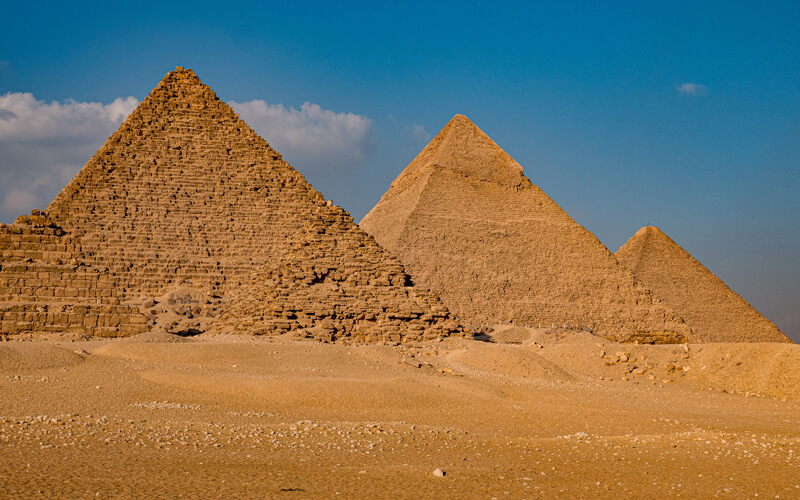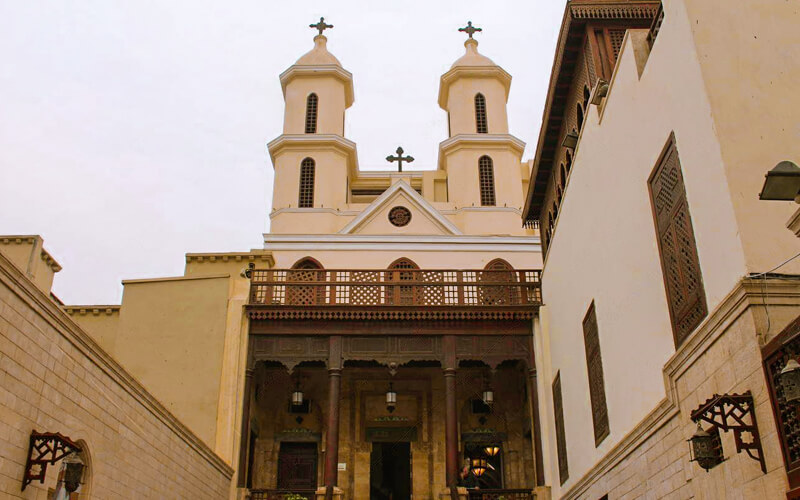the Pyramids of Egypt
Egyptian Pyramids Facts
The first stage in constructing a pyramid was identifying an appropriate location. There was no way this could be on the east bank of the Nile since it was on the west side that the sun sank and where it was believed the deceased entered the underworld. Also necessary was a location on highland, away from any potential flooding during the Nile’s inundation, so that the pyramids could be built.
Because the river would be used to carry blocks of good-grade limestone for the outer casing from Tura, which is on the opposite side of the Nile, it could not be too far away from the bank. On the desert plateau, a location would be selected that would provide a rock basis that would be capable of sustaining the massive weight of a structure such as a pyramid without the fear of it crumbling under its weight. It would also have to be within easy reach of the capital for the king to be able to visit and check the construction process anytime he desired.
Memphis, the Sacred City of the Gods:
Some of Cairo’s oldest constructions stretch back over two centuries before the Greco-Roman period; however, the Giza Pyramids are widely regarded as the most renowned and oldest of all the pyramids in Egypt, having been built nearly two centuries before the beginning of the Roman era. Even though the pyramids are near Cairo city, the gap in time between the construction of the pyramids and the establishment of the city itself demonstrates that they have separate histories.
The pyramids of Giza were a part of an ancient city heritage and civilization that existed long before Cairo was established. The ancient city of Memphis served as the administrative center of Ancient Egypt’s Old Kingdom (2686–2181 BC), and it was also the birthplace of the Egyptians who erected the Great Pyramid of Giza.
It’s one of the most intriguing Egyptian pyramid facts to know that Memphis was the most powerful and well-known city in the world throughout that period, not just in Egypt but around the globe. What made it particularly well-known was the fact that, during that period, about 100 pyramids were constructed in and around Cairo alone.
The fact that Cairo is located close to the city of Memphis demonstrates how significant Memphis was throughout ancient Egyptian history. Furthermore, both Cairo and Memphis were, and continue to be, positioned in the northernmost portion of the Nile Delta.
Giza Necropolis (also known as Giza Pyramids):
In Egypt, the Giza Pyramids are associated with the country’s name as well. The immense scale of the pyramids, particularly the Giza pyramids, has always been and will continue to be awe-inspiring to the millions of visitors that visit Egypt every year. The element of surprise stems from the question that every visitor to Egypt has: how did the three rulers of Egypt, Khafre, Khufu, and Menkaure, manage to construct such massive structures?
Cheops Pyramid (also known as the Pyramid of Khufu):
Egypt pyramids facts abound, and one remarkable fact is that the Khufu pyramid, also known as the Great Pyramid of Giza, is regarded to be one of the Seven Wonders of the Ancient World, and is considered to be one of the Seven Wonders of the Ancient World.
Khafre, the son of Khufu, and king Menkaure are both recognized for their stunning pyramids at Giza, but none of the two pyramids is as large as the enormous pyramid of King Khufu, which stands at a height of 450 meters. After being completed in 2560 BC, the Great Pyramid stands at a height of 481 feet, which has since been reduced to 455 feet as a result of the loss of its magnificent capstone.
Archeologists now consider ancient Egyptian monuments such as the pyramids to be important indications of Egypt’s economic and political stability throughout the Old and Middle Kingdoms periods of ancient history, and they are correct. A great deal of work was expended on obtaining the appropriate and competent labor force for the building of the pyramid, as well as in obtaining the necessary resources. In ancient Egyptian history, the enormous size and superior structure of pyramids built at various times throughout the 4th dynasty demonstrate that there were more sophisticated building materials accessible at that time than at any other point in the history of that civilization.
Chefren’s Pyramid (also known as the Khafre Pyramid):
The Khafre Pyramid is the second-largest structure at Giza, behind the Great Pyramid. It was constructed for King Khafre, the third pharaoh of Ancient Egypt’s Old Kingdom, who belonged to the 4th Dynasty and reigned during the period of the Old Kingdom (2540 BC). The monarch was also known by the Greek given name Chephren, which was also used to refer to him. He was the son of King Khufu, who was responsible for the construction of the Great Pyramid of Giza, and the grandson of King Sneferu.
The pyramids erected by king Khafre and his family during the ‘golden period of the Old Kingdom are often regarded as the most significant structures in Egyptian and human history, as well as the world.
Another notable building from ancient Egyptian history is the Great Sphinx statue, which is also known as the Great Sphinx. It was constructed to safeguard the burial place of the monarchs at Giza, Egypt.
Located adjacent to the Valley Temple, which is near the Pyramid of Khafre, is the Great Sphinx monument. It was discovered during excavations that a colossal statue of the king had been erected adjacent to the Great Sphinx monument.
Menkaure’s Pyramid (also known as the Mycerinus Pyramid):
The Pyramid of Menkaure is the third and smallest of the great pyramids of Giza, and it is located in the southern part of the city. It is the property of King Menkaure (Mycerinus in Greek). Archeologists assume that it was completed by the end of the 26th century BC, according to their findings. King Menkaure governed Egypt during the 4th Dynasty, which corresponded to the period of Ancient Egyptian history known as the Old Kingdom Period, along with the other rulers who owned pyramids at Giza.
Several archeological evidence implies that Menkaure is the heir apparent to King Khafre, who was the owner of the second pyramid and the statue of the Great Sphinx, however, some historical records disagree with this interpretation of events.
The pyramid of Menkaure was once 215 feet tall, but its current height is 204 feet tall as a result of the removal of the pyramid’s outer casing and capstone, which reduced the height of the pyramid to 204 feet. The lowest half of the pyramid of Menkaure, like the other pyramids in Giza, was encased in pink granite, while the upper sections of the pyramid were encased in white Tura limestone, much like the other pyramids in Giza.
The Great Sphinx of Giza (also known as the Great Pyramid):
During the beginning of the dynasty era, sculptures such as the great Sphinx arose in Egypt for the first time as a form of the depiction of a two-sided tale behind each construction of a statue, with the body of a lion and the head of a human. The earliest depiction of a monarch in the shape of a statue of the great sphinx was made towards the middle of the 4th dynasty, according to historical records.
It is believed that Monarch Djetef Ra, the successor of King Cheops, was the first king to be presented with a Sphinx statue; this is regarded to be the world’s first royal representation of its sort in the shape of a Sphinx. According to legend, the statue was unearthed near the pyramid of Abu-Rawash in Giza, and it is presently on exhibit in the Louvre Museum.
So, what exactly is the significance of the “Sphinx”?
In its original form, the term “Sphinx” was derived from the Ancient Egyptian name “Ssp Ankh,” which translates as “alive picture or representation of anything.” Among other things, the Sphinx statue signifies the monarch and his living image, as well as a union of mental and physical might. Although the statue has a human head, the physical might of the monarch is portrayed by a lion’s body, which represents the king’s mental strength. If the sphinx was a depiction of an ancient Egyptian God, Egyptology specialists think that they were able to tame the savage nature of the lion with the help of human wisdom, transforming it into a heavenly calm character as a result.
The Pyramids of Dahshur:
The hamlet of Dahshur, which is approximately 40 kilometers southwest of Cairo, is well-known for its amazing ancient buildings, which date back thousands of years. In addition to large tomb complexes that were erected for queens and nobles from Memphis city up to the 13th Dynasty during the period of the Middle Kingdom, excavation operations at the Dahshur site have uncovered the ruins of a total of seven pyramids up to this point.
Both the Bent Pyramid at Dahshur and the Red Pyramid at Dahshur, which were built during the reign of King Sneferu (2613-2589 BC), the founder of the 4th Dynasty, are excellent examples of the impressive structural development that was evident in the construction of the Great Pyramid of Giza and other ancient Egyptian pyramids at the time of their construction.
The Red Pyramid in Dahshur is a colossal structure that towers over the surrounding landscape.
The Red Pyramid, which was erected for the pharaoh Sneferu, is another impressive example of a large building project that took place during the 4th Dynasty. Sneferu decided to correct the flaws that were made during the construction of the bent pyramid and the one at Meidum, which collapsed during its construction. Another example is the Bent Pyramid, which is located at the same site, close to the Necropolis at Dahshur city, and was built on the same foundation.
Upon completion of the Red Pyramid, which was completed around the beginning of the 26th century BC, it was widely regarded as the first successful effort to create a full pyramid, and as such, it was the most inspiring style of building for the subsequent 4th Dynasty pyramids of Giza.
The Dahshur Pyramid with a Bended Top:
The Bent Pyramid at the Dahshur site was constructed around the end of the 27th century BC by King Sneferu, the father of King Khufu, who was the owner of the Great Pyramid of Giza at the time of construction. The Bent Pyramid was the first of King Sneferu’s pyramids to be completed; it was given this name because it was left incomplete and needed to be restored, but the King opted to leave it as is.
If you want to spend a fantastic vacation check out our amazing Egypt Vacation packages or Cairo Excursions to find the best way to travel to Egypt for you with Egypt Travel Guide.



